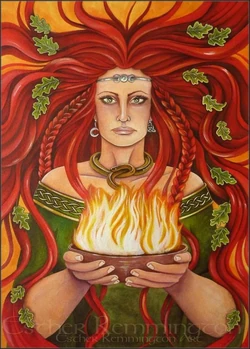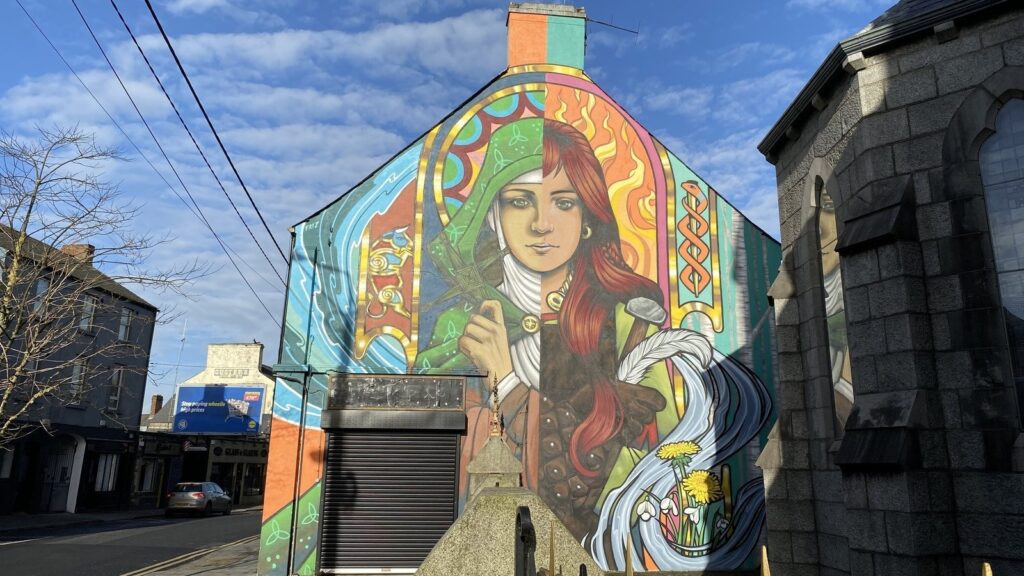
Saint or goddess? Mythical brewer? Kildare’s break reveals the woman honored with her own February 1st holiday.
In the pub of Judith Boyle, a publican and brewer from a beer-centric family with a five-generation history, her words might lead you to believe she’s discussing a kin involved in ale production. However, she is actually alluding to St. Brigid, the patron saint of, among other things, beer, as I discovered during my visit to her namesake bar in the commuter town of Kildare, just a 30-minute train ride from Dublin.
Judith recounts the tale: “She turned dirty water into beer and shared a single pot of ale with her entire parish of 18 churches.” I sip on her latest batch of Brigid Ale, a malty braggot sweetened with honey from her beekeeper dad’s hives. “Every January, we craft Brigid’s crosses, and on February 1st, children in the town enjoy a day off school.”
This year, it’s not just Kildare schoolchildren granted a day off. In 2023, the Irish government, following extensive advocacy, introduced a new public holiday to the national calendar, and Brigid’s feast day was the chosen occasion.
The saga of Brigid originates in AD451, but in Kildare, the journey commences at the Heritage Centre through a virtual reality escapade – the first stop on the St Brigid’s Trail. The following morning, I venture there and don a VR headset, immersing myself in the world of Brigid, the pagan goddess of fire. Before long, I find myself soaring through 1,500 years of history on the wing of a peregrine falcon.
“Brigid is an ancient name,” explains Tom McCutcheon, my guide and the center manager. “It traces back to the Celtic mother goddess, Danu. Before Christianity, people revered deities and goddesses, with Brigid being one of them.
Despite the chilly weather and dark nights in late January, there’s a vibrant atmosphere in Kildare. The excitement stems from the upcoming 1 February, marking 1,500 years since St Brigid’s passing. The town plans two weeks of festivities, including fire and light displays, guided meditative walks, craft workshops, music concerts, and storytelling sessions for children.
Following my encounter with the goddess, I’m virtually introduced to Brigid the farmer through VR technology. She is the daughter of a slave and a respected free man. In this immersive experience, I witness her engaged in the act of milking cows and selflessly giving her father’s sword to a homeless family, allowing them to sell it for food. Subsequently, she seamlessly transforms into the saint whose name graces the nearby cathedral and church, just a few minutes’ walk away.
“The Irish name for Kildare is Cill Dara – the church of the oak,” Tom explains. The cathedral stands on the spot where St Brigid established her first monastery.
I stroll towards the cathedral grounds, currently accessible only for Sunday masses and special events. A massive stone structure towers over the town’s other buildings. According to tradition, in AD480, Brigid arrived here and established a co-ed monastery, instructing both men and women.
Amidst the Christian symbols, an aged Celtic cross stands, weathered by time. Adjacent to it is a rectangular stone enclosure believed to designate the location where the Celtic goddess kindled her flame, tended by nuns for centuries.
The flame that once burned here, believed to have been extinguished during the 16th-century Reformation, no longer flickers. However, on the southern outskirts of town, within the spiritual hub known as Solas Bhride, the last two Brigidine sisters safeguard a rekindled version. Despite the evident Christian connection with the nuns, a dual nature persists. Their schedule encompasses both religious and secular activities – from meditation sessions to historical lectures. The nuns explain that they adhere to both the liturgical and natural calendars.
“We mark the rhythm of the year,” Sister Phil O’Shea shares as we sit in front of the flickering light. “This includes both the equinoxes and the solstices, as well as Advent, Easter, and Christian feasts.
I participate in a cross-weaving workshop with Phil, discovering that while a cross symbolizes the crucifix, its four arms are also interpreted as representing the seasons and the elements. “Some perceive Brigid solely as a goddess, while others see Brigid the saint as an embodiment of the goddess. Each generation reinvents the legend in their own way,” notes Phil.

The center provides three self-contained, circular-shaped hermitages for individuals of all faiths (or none) to engage in quiet reflection, devoid of TV or Wi-Fi. The notion of embracing a hermit-like seclusion appeals to me, but it seems I’m not alone, as all hermitages are booked. Consequently, I return to Kildare to my more luxurious hermit cell at Rooms at Firecastle (starting from €130 B&B). My room boasts a king-size bed, rainforest shower, and a sizable picture window with views of the cathedral.
The following day, I explore the last two sites on Brigid’s Trail, including her holy well adorned with woven Brigid crosses and rosary beads hanging from church-like lancet arcs. A pagan clootie tree adorned with ribbons in honor of the goddess, graces the surroundings. I also visit her eponymous parish church, where worshippers chant prayers in Irish while a gospel choir rehearses for the Brigid celebration on February 1st, also coinciding with Imbolc in the pre-Christian calendar, marking the onset of spring.
In the intervals between visiting sites, I engage in conversations with locals at Hartes gastropub, known for its commitment to serving sustainable, traceable, and seasonal meat and produce. Here, I come across the local legend explaining the origins of Kildare. Allegedly, the king of Leinster, known for his stinginess, was approached by Brigid with a request to establish her monastery on the hilltop. The king, skeptical, stipulated that she could only claim the land she could cover with her cloak. Undeterred, Brigid agreed and cast her mantle, covering the entire town and the surrounding rolling grassland, referred to as The Curragh or, locally, Brigid’s Pastures.
On my concluding morning, I explore the 2,000 hectares that Brigid managed to secure. Although there are no established walking trails yet, Sister Phil mentioned plans to create one that connects “all corners of Brigid’s cloak.” Undeterred, I meander on my own across the rolling terrain. After half an hour, I find myself within a rectangle of deciduous trees, an old fox’s covert, and encounter an oak peace pole placed here by the Friends of St Brigid, Cairde Bhride.
Having spent a long weekend in Kildare, my fascination with Brigid has only deepened. She embodies the roles of a goddess, saint, and a woman advocating for helping others, empowering women, caring for the environment, and notably, ensuring there’s enough beer for everyone.



